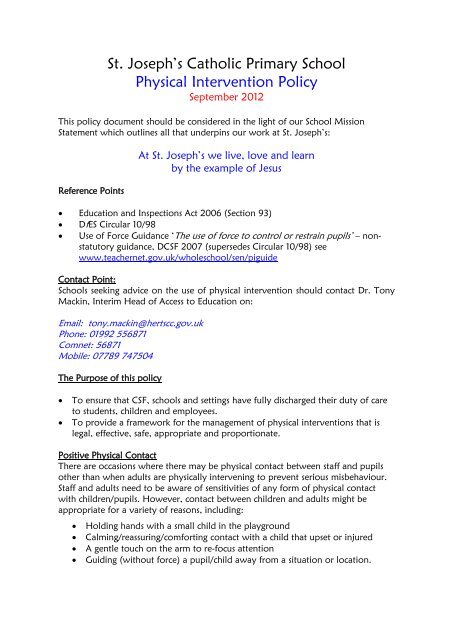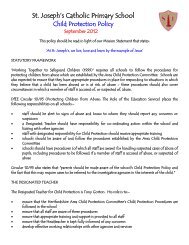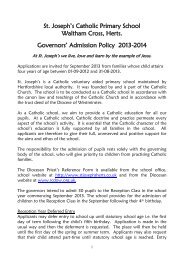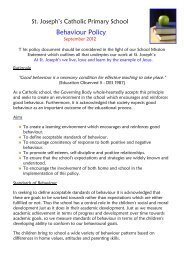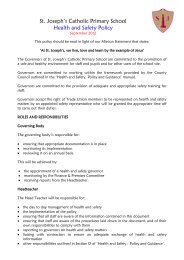hertfordshire's policy on physical intervention in schools
hertfordshire's policy on physical intervention in schools
hertfordshire's policy on physical intervention in schools
Create successful ePaper yourself
Turn your PDF publications into a flip-book with our unique Google optimized e-Paper software.
St. Joseph’s Catholic Primary School<br />
Physical Interventi<strong>on</strong> Policy<br />
September 2012<br />
This <str<strong>on</strong>g>policy</str<strong>on</strong>g> document should be c<strong>on</strong>sidered <strong>in</strong> the light of our School Missi<strong>on</strong><br />
Statement which outl<strong>in</strong>es all that underp<strong>in</strong>s our work at St. Joseph’s:<br />
Reference Po<strong>in</strong>ts<br />
At St. Joseph’s we live, love and learn<br />
by the example of Jesus<br />
Educati<strong>on</strong> and Inspecti<strong>on</strong>s Act 2006 (Secti<strong>on</strong> 93)<br />
DfES Circular 10/98<br />
Use of Force Guidance ‘The use of force to c<strong>on</strong>trol or restra<strong>in</strong> pupils’ – n<strong>on</strong>statutory<br />
guidance, DCSF 2007 (supersedes Circular 10/98) see<br />
www.teachernet.gov.uk/wholeschool/sen/piguide<br />
C<strong>on</strong>tact Po<strong>in</strong>t:<br />
Schools seek<strong>in</strong>g advice <strong>on</strong> the use of <strong>physical</strong> <strong>in</strong>terventi<strong>on</strong> should c<strong>on</strong>tact Dr. T<strong>on</strong>y<br />
Mack<strong>in</strong>, Interim Head of Access to Educati<strong>on</strong> <strong>on</strong>:<br />
Email: t<strong>on</strong>y.mack<strong>in</strong>@hertscc.gov.uk<br />
Ph<strong>on</strong>e: 01992 556871<br />
Comnet: 56871<br />
Mobile: 07789 747504<br />
The Purpose of this <str<strong>on</strong>g>policy</str<strong>on</strong>g><br />
<br />
<br />
To ensure that CSF, <strong>schools</strong> and sett<strong>in</strong>gs have fully discharged their duty of care<br />
to students, children and employees.<br />
To provide a framework for the management of <strong>physical</strong> <strong>in</strong>terventi<strong>on</strong>s that is<br />
legal, effective, safe, appropriate and proporti<strong>on</strong>ate.<br />
Positive Physical C<strong>on</strong>tact<br />
There are occasi<strong>on</strong>s where there may be <strong>physical</strong> c<strong>on</strong>tact between staff and pupils<br />
other than when adults are <strong>physical</strong>ly <strong>in</strong>terven<strong>in</strong>g to prevent serious misbehaviour.<br />
Staff and adults need to be aware of sensitivities of any form of <strong>physical</strong> c<strong>on</strong>tact<br />
with children/pupils. However, c<strong>on</strong>tact between children and adults might be<br />
appropriate for a variety of reas<strong>on</strong>s, <strong>in</strong>clud<strong>in</strong>g:<br />
<br />
<br />
<br />
<br />
Hold<strong>in</strong>g hands with a small child <strong>in</strong> the playground<br />
Calm<strong>in</strong>g/reassur<strong>in</strong>g/comfort<strong>in</strong>g c<strong>on</strong>tact with a child that upset or <strong>in</strong>jured<br />
A gentle touch <strong>on</strong> the arm to re-focus attenti<strong>on</strong><br />
Guid<strong>in</strong>g (without force) a pupil/child away from a situati<strong>on</strong> or locati<strong>on</strong>.
Any <strong>physical</strong> c<strong>on</strong>tact has to be managed <strong>in</strong> order to make sure that it is appropriate<br />
and leaves neither party vulnerable to allegati<strong>on</strong>s of abuse. Factors to c<strong>on</strong>sider<br />
might <strong>in</strong>clude:<br />
Knowledge of the child, e.g. history/background<br />
Age (and age difference) – of child and adult<br />
C<strong>on</strong>text – where, when, why<br />
Relati<strong>on</strong>ship between staff member and child<br />
Gender<br />
Planned <strong>physical</strong> <strong>in</strong>terventi<strong>on</strong> can be viewed as positive, because it is committed to<br />
keep<strong>in</strong>g children and adults safe and <strong>in</strong>cluded <strong>in</strong> all sett<strong>in</strong>gs.<br />
What the law says about restrictive <strong>physical</strong> <strong>in</strong>terventi<strong>on</strong>:<br />
School staff can use such force as is reas<strong>on</strong>able <strong>in</strong> the circumstances to prevent a<br />
pupil from do<strong>in</strong>g, or c<strong>on</strong>t<strong>in</strong>u<strong>in</strong>g to do, any of the follow<strong>in</strong>g:<br />
Committ<strong>in</strong>g any offence (or, for a pupil under the age of crim<strong>in</strong>al<br />
resp<strong>on</strong>sibility, what would be an offence for an older pupil);<br />
Caus<strong>in</strong>g pers<strong>on</strong>al <strong>in</strong>jury to, or damage to the property of, any pers<strong>on</strong><br />
(<strong>in</strong>clud<strong>in</strong>g the pupil him/herself); or<br />
Prejudic<strong>in</strong>g the ma<strong>in</strong>tenance of good order and discipl<strong>in</strong>e at the school or<br />
am<strong>on</strong>g any pupils receiv<strong>in</strong>g educati<strong>on</strong> at the school, whether dur<strong>in</strong>g a<br />
teach<strong>in</strong>g sessi<strong>on</strong> or otherwise.<br />
Def<strong>in</strong>iti<strong>on</strong>s of ‘school staff’:<br />
<br />
<br />
Any teacher who works at the school; and<br />
Any other pers<strong>on</strong> whom the head has authorised to have c<strong>on</strong>trol or charge<br />
of pupils. This:<br />
1. <strong>in</strong>cludes support staff whose job normally <strong>in</strong>cludes supervis<strong>in</strong>g pupils,<br />
such as teach<strong>in</strong>g assistants, learn<strong>in</strong>g support assistants, learn<strong>in</strong>g mentors<br />
and lunchtime supervisors.<br />
2. can also <strong>in</strong>clude people to whom the head has given temporary<br />
authorisati<strong>on</strong> to have c<strong>on</strong>trol or charge of pupils, such as paid<br />
members of staff whose job doesn’t normally <strong>in</strong>volve supervis<strong>in</strong>g<br />
pupils (e.g. cater<strong>in</strong>g or premises staff) and unpaid volunteers (e.g.<br />
parents accompany<strong>in</strong>g pupils <strong>on</strong> school-organised visits).<br />
3. does NOT <strong>in</strong>clude prefects or any other pupils .<br />
This power may be used where a pupil (<strong>in</strong>cl. <strong>on</strong>e from another school) is <strong>on</strong> school<br />
premises or <strong>in</strong> the lawful c<strong>on</strong>trol or charge of the member of staff – e.g. <strong>on</strong> a school<br />
visit.<br />
Reas<strong>on</strong>able force:<br />
<br />
There is no legal def<strong>in</strong>iti<strong>on</strong> of when it is reas<strong>on</strong>able to use force. That will<br />
always depend <strong>on</strong> the precise circumstances of <strong>in</strong>dividual cases. To be judged
lawful, the force would need to be <strong>in</strong> proporti<strong>on</strong> to the c<strong>on</strong>sequences it is<br />
<strong>in</strong>tended to prevent.<br />
<br />
<br />
<br />
The degree of force should be the m<strong>in</strong>imum needed to achieve the desired<br />
result.<br />
Use of force could not be justified to prevent trivial misbehaviour. However,<br />
decid<strong>in</strong>g whether misbehaviour is trivial also depends <strong>on</strong> circumstances e.g.<br />
runn<strong>in</strong>g <strong>in</strong> a corridor crowded with small children may be c<strong>on</strong>sidered<br />
dangerous.<br />
Proper account must always be taken of any particular special educati<strong>on</strong>al<br />
need and/or disability that a pupil might have – there are 2 key duties under<br />
the Disability Discrim<strong>in</strong>ati<strong>on</strong> Act:<br />
1. not to treat a disabled pupil less favourably, for a reas<strong>on</strong> relat<strong>in</strong>g<br />
to his/her disability, than some<strong>on</strong>e to whom that reas<strong>on</strong> does not<br />
apply, without justificati<strong>on</strong>; and<br />
2. to take reas<strong>on</strong>able steps to avoid putt<strong>in</strong>g disabled pupils at a<br />
substantial disadvantage to pupils who are not disabled<br />
(reas<strong>on</strong>able adjustments).<br />
The statutory power described above is <strong>in</strong> additi<strong>on</strong> to the comm<strong>on</strong> law power of<br />
any citizen - <strong>in</strong> an emergency - to use reas<strong>on</strong>able force <strong>in</strong> self-defence, to prevent<br />
another pers<strong>on</strong> from be<strong>in</strong>g <strong>in</strong>jured or committ<strong>in</strong>g a crim<strong>in</strong>al offence. NB There is<br />
NO legal requirement for practical tra<strong>in</strong><strong>in</strong>g <strong>in</strong> techniques of <strong>physical</strong> <strong>in</strong>terventi<strong>on</strong>.<br />
When deal<strong>in</strong>g with an emergency, any adult who is lawfully placed <strong>in</strong> charge of<br />
pupils by a Head Teacher can use reas<strong>on</strong>able and proporti<strong>on</strong>ate <strong>physical</strong><br />
<strong>in</strong>terventi<strong>on</strong> even if he/she has had no prior tra<strong>in</strong><strong>in</strong>g.<br />
Reas<strong>on</strong>able force may also be used to search pupils, without their c<strong>on</strong>sent, for<br />
weap<strong>on</strong>s, however, <strong>schools</strong> are str<strong>on</strong>gly advised not to search pupils where<br />
resistance is expected, but to call the police.<br />
It is always unlawful to use force as a punishment.<br />
Policy Management and Guidance:<br />
Schools must have a <str<strong>on</strong>g>policy</str<strong>on</strong>g> <strong>on</strong> the use of reas<strong>on</strong>able force to c<strong>on</strong>trol or restra<strong>in</strong><br />
pupils. This <str<strong>on</strong>g>policy</str<strong>on</strong>g> should have regard to the documents listed <strong>in</strong> the Reference<br />
Po<strong>in</strong>ts above. It is good practice for governors, staff, pupils and those with parental<br />
resp<strong>on</strong>sibility to be c<strong>on</strong>sulted about the <str<strong>on</strong>g>policy</str<strong>on</strong>g> and for the <str<strong>on</strong>g>policy</str<strong>on</strong>g> to be approved<br />
formally by the Govern<strong>in</strong>g Body and made known to all stakeholders either as part<br />
of the school’s behaviour <str<strong>on</strong>g>policy</str<strong>on</strong>g> or separately. Appropriate account should be taken<br />
of the needs of <strong>in</strong>dividual pupils with SEN and/or disabilities <strong>in</strong>clud<strong>in</strong>g ‘fragile’<br />
pupils.<br />
The DCSF Guidance (2007) c<strong>on</strong>ta<strong>in</strong>s some explicit key messages:
Str<strong>on</strong>g emphasis <strong>on</strong> staff tra<strong>in</strong><strong>in</strong>g <strong>in</strong> de-escalati<strong>on</strong> strategies al<strong>on</strong>gside <strong>physical</strong><br />
<strong>in</strong>terventi<strong>on</strong> skills – this should <strong>in</strong>clude support staff, lunchtime supervisors<br />
etc.<br />
Acknowledges the potential for <strong>in</strong>jury to children/pupils and staff <strong>in</strong>volved <strong>in</strong><br />
<strong>physical</strong> <strong>in</strong>terventi<strong>on</strong> resp<strong>on</strong>ses<br />
Schools should have a <str<strong>on</strong>g>policy</str<strong>on</strong>g> <strong>on</strong> the use of reas<strong>on</strong>able force to c<strong>on</strong>trol pupils,<br />
al<strong>on</strong>g side the behaviour <str<strong>on</strong>g>policy</str<strong>on</strong>g><br />
No school should have a <str<strong>on</strong>g>policy</str<strong>on</strong>g> of ‘No Physical C<strong>on</strong>tact’ (<strong>schools</strong> cannot<br />
deprive staff of their statutory power or h<strong>in</strong>der their exercise of it.)<br />
All staff need to understand their powers and opti<strong>on</strong>s open to them – what is<br />
acceptable and what is not<br />
Reference to the <str<strong>on</strong>g>policy</str<strong>on</strong>g> <strong>on</strong> the use of force to c<strong>on</strong>trol or restra<strong>in</strong> pupils should be<br />
made <strong>in</strong> the <strong>in</strong>formati<strong>on</strong>, which the school gives to parents about its <str<strong>on</strong>g>policy</str<strong>on</strong>g> <strong>on</strong><br />
discipl<strong>in</strong>e and standards of behaviour.<br />
Pupils with SEN and/or disabilities:<br />
Where a school is aware that an <strong>in</strong>dividual pupil may be at greatest risk of need<strong>in</strong>g<br />
restrictive <strong>physical</strong> <strong>in</strong>terventi<strong>on</strong>s, it should be planned for <strong>in</strong> c<strong>on</strong>sultati<strong>on</strong> with the<br />
pupil and his/her parents, follow<strong>in</strong>g an <strong>in</strong>dividual risk assessment. A model risk<br />
assessment form can be found as an annex to the “Restrictive Physical Interventi<strong>on</strong><br />
model <str<strong>on</strong>g>policy</str<strong>on</strong>g>” for <strong>schools</strong>, see:<br />
http://www.thegrid.org.uk/learn<strong>in</strong>g/behaviour/policies/<br />
<br />
<br />
<br />
The positive handl<strong>in</strong>g plan should set out the techniques that should be used,<br />
and those that shouldn’t normally be used<br />
The plan should be compatible with the pupil’s statement and properly<br />
documented with the pupil’s records.<br />
As far as practically possible, make staff who come <strong>in</strong>to c<strong>on</strong>tact with the<br />
pupil aware of the relevant <strong>in</strong>formati<strong>on</strong> <strong>in</strong> the plan, i.e.<br />
o Triggers known to provoke difficult behaviour, preventive strategies &<br />
what de-escalati<strong>on</strong> tactics most likely to work<br />
o Triggers known to provoke a violent reacti<strong>on</strong>, <strong>in</strong>clud<strong>in</strong>g relevant<br />
<strong>in</strong>formati<strong>on</strong> relat<strong>in</strong>g to similar <strong>in</strong>cidents <strong>in</strong> the past<br />
o Where <strong>physical</strong> <strong>in</strong>terventi<strong>on</strong> likely to be needed, detail specific<br />
strategies & techniques that have been agreed by staff, parents and<br />
pupil.<br />
o Decide which staff members should be called for the <strong>in</strong>dividual pupil<br />
c<strong>on</strong>cerned – not necessarily to take the acti<strong>on</strong>, but to be <strong>in</strong>volved <strong>in</strong><br />
the follow-up process.<br />
<br />
Pupils known to be at risk should be taught how to communicate <strong>in</strong> times of<br />
crisis and what strategies they can use. All staff work<strong>in</strong>g with the pupil should<br />
be made aware of these strategies.
Risk assessments:<br />
Schools are advised to assess the frequency and severity of <strong>in</strong>cidents requir<strong>in</strong>g use of<br />
force that are likely to occur <strong>in</strong> their <strong>schools</strong> and use these assessments to <strong>in</strong>form<br />
staff tra<strong>in</strong><strong>in</strong>g.<br />
Schools should seek to provide <strong>in</strong>itial and refresher tra<strong>in</strong><strong>in</strong>g for staff <strong>on</strong> the<br />
behaviour management policies and codes of c<strong>on</strong>duct determ<strong>in</strong>ed by the school. In<br />
particular, staff should be given the clearest possible judgement about what<br />
situati<strong>on</strong>s the school c<strong>on</strong>siders justify <strong>physical</strong> <strong>in</strong>terventi<strong>on</strong>. DCSF ‘Use of Force<br />
Guidance’ 2007 gives some useful examples.<br />
Schools should actively review such tra<strong>in</strong><strong>in</strong>g and its relevance <strong>on</strong> a regular basis as<br />
part of the Behaviour Management Policy, of which the use of <strong>physical</strong> <strong>in</strong>terventi<strong>on</strong><br />
should form <strong>on</strong>ly a part. Individual risk assessments should highlight specific areas<br />
for tra<strong>in</strong><strong>in</strong>g. If there is a significant risk that staff may need to use <strong>physical</strong><br />
<strong>in</strong>terventi<strong>on</strong> then the school should c<strong>on</strong>sider provid<strong>in</strong>g them with tra<strong>in</strong><strong>in</strong>g <strong>in</strong><br />
practical techniques of safe <strong>physical</strong> <strong>in</strong>terventi<strong>on</strong> from a tra<strong>in</strong>er associated with an<br />
accredited tra<strong>in</strong><strong>in</strong>g organisati<strong>on</strong>. Further <strong>in</strong>formati<strong>on</strong> about practical tra<strong>in</strong><strong>in</strong>g can be<br />
obta<strong>in</strong>ed from the Head of Access to Educati<strong>on</strong> (c<strong>on</strong>tact details above).<br />
NB there is no legal requirement for staff to be tra<strong>in</strong>ed <strong>in</strong> the use of practical<br />
techniques so staff may exercise their legal right to <strong>physical</strong>ly <strong>in</strong>tervene even if they<br />
have not had such tra<strong>in</strong><strong>in</strong>g. However, they would still need to dem<strong>on</strong>strate that<br />
their <strong>in</strong>terventi<strong>on</strong> was reas<strong>on</strong>able and proporti<strong>on</strong>ate.<br />
Situati<strong>on</strong>s where staff should not normally <strong>in</strong>tervene without help:<br />
Help may sometimes be needed <strong>in</strong> deal<strong>in</strong>g with a situati<strong>on</strong> <strong>in</strong>volv<strong>in</strong>g an older pupil,<br />
a large pupil, more than <strong>on</strong>e pupil, or if the authorised member of staff believes<br />
s/he may be at risk of <strong>in</strong>jury. For such situati<strong>on</strong>s, staff need to have an agreed system<br />
of communicati<strong>on</strong> for summ<strong>on</strong><strong>in</strong>g help quickly. The member of staff should also<br />
take steps to remove other pupils who might be at risk.<br />
Record<strong>in</strong>g and Report<strong>in</strong>g Incidents:<br />
Schools are str<strong>on</strong>gly advised to keep systematic records of every significant <strong>in</strong>cident<br />
<strong>in</strong> which force has been used. Such records can be used to provide evidence of<br />
defensible decisi<strong>on</strong>-mak<strong>in</strong>g <strong>in</strong> case of a subsequent compla<strong>in</strong>t or <strong>in</strong>vestigati<strong>on</strong>. The<br />
DCSF guidance above provides a model record<strong>in</strong>g form.<br />
When record<strong>in</strong>g such <strong>in</strong>cidents, staff should bear <strong>in</strong> m<strong>in</strong>d that, if this <strong>in</strong>formati<strong>on</strong> is<br />
passed to the police, it may be <strong>in</strong>cluded <strong>in</strong> a Crim<strong>in</strong>al Records Bureau disclosure.<br />
Schools should reta<strong>in</strong> records of such <strong>in</strong>cidents until the member of staff <strong>in</strong>volved<br />
has reached retirement age or for 10 years from the date of the allegati<strong>on</strong> if that is<br />
l<strong>on</strong>ger.
After any recordable <strong>in</strong>cident, it is good practice to ensure that parents are <strong>in</strong>formed<br />
as so<strong>on</strong> after the event as possible. (However, there is no l<strong>on</strong>ger a statutory<br />
requirement to do this). Governors should also be <strong>in</strong>formed <strong>in</strong> due course.<br />
Any <strong>in</strong>juries to staff or pupils should be reported under the school’s Health & Safety<br />
procedures<br />
Deal<strong>in</strong>g With Compla<strong>in</strong>ts and Allegati<strong>on</strong>s:<br />
If a specific allegati<strong>on</strong> of abuse is made aga<strong>in</strong>st a member of staff then the school<br />
needs to follow the guidance set out <strong>in</strong> its child protecti<strong>on</strong> procedures.<br />
Review Date: September 2013


